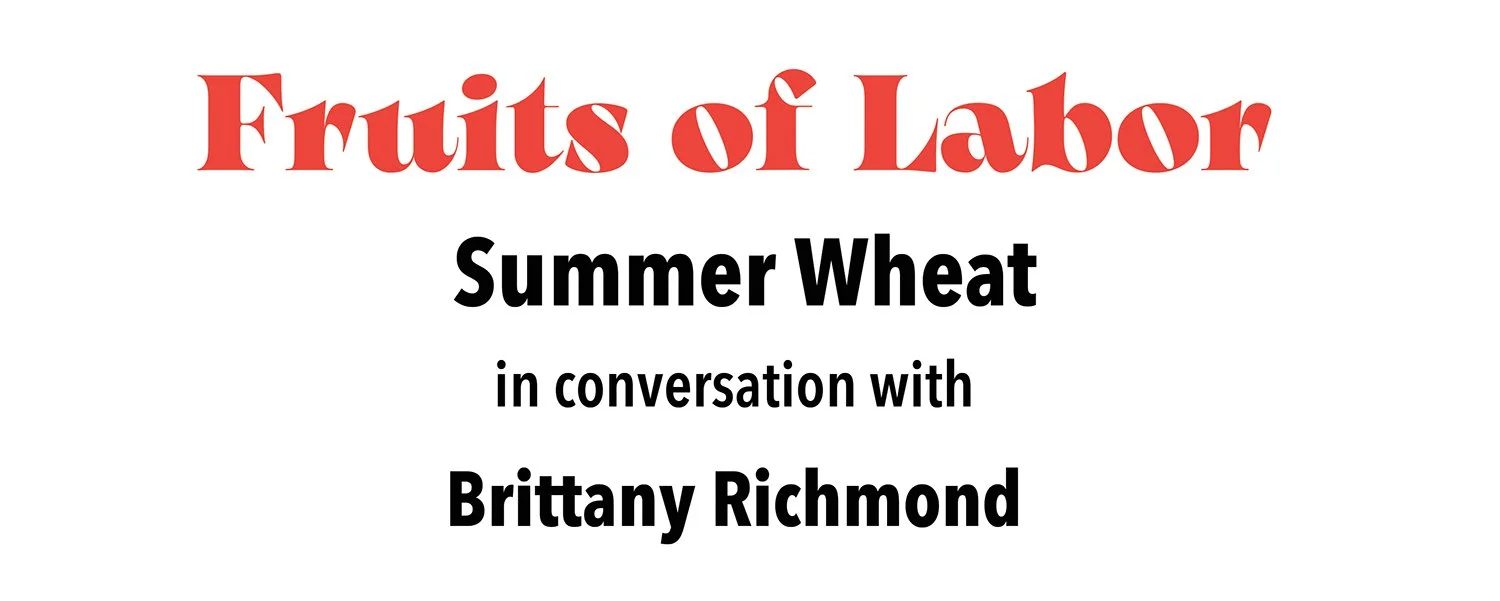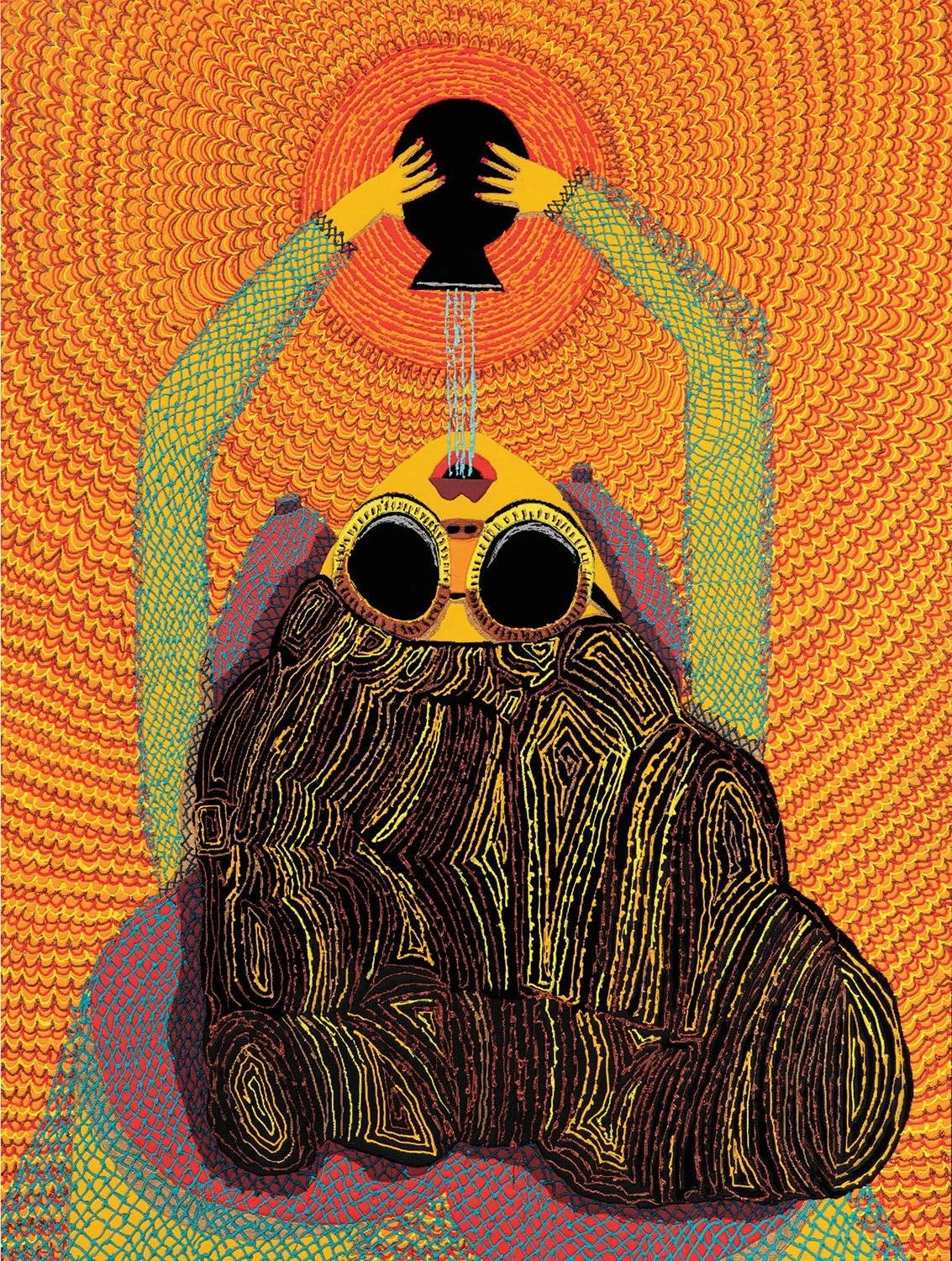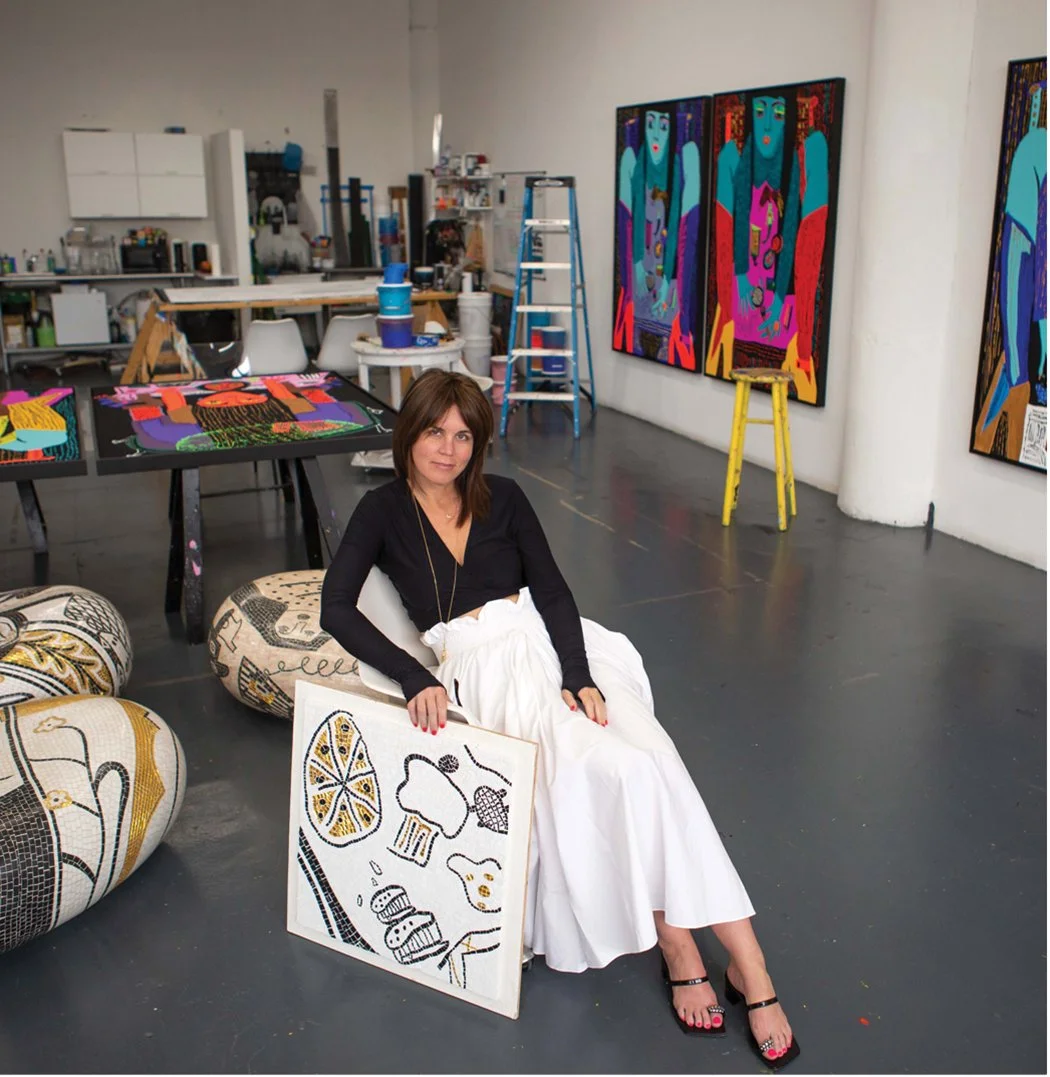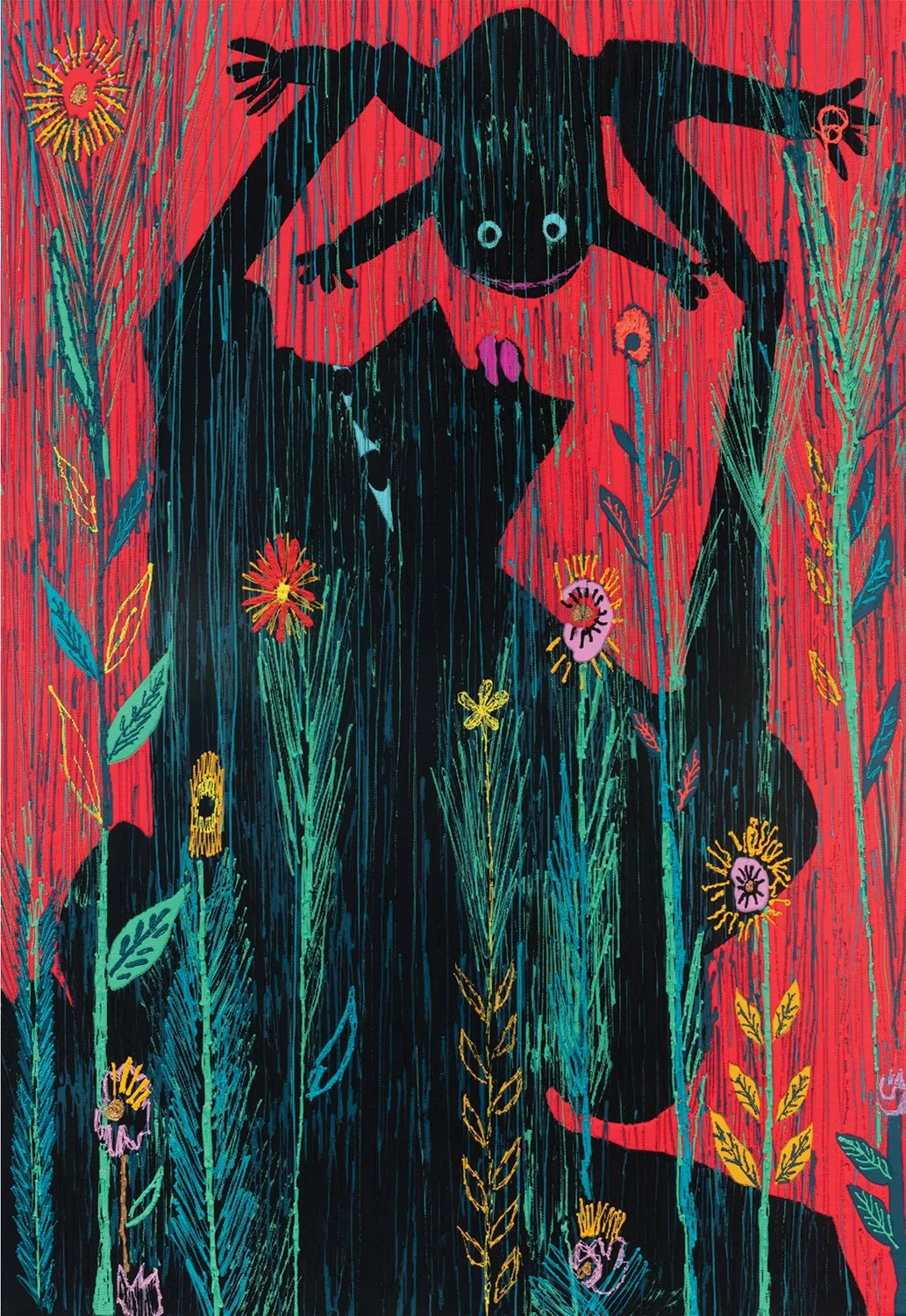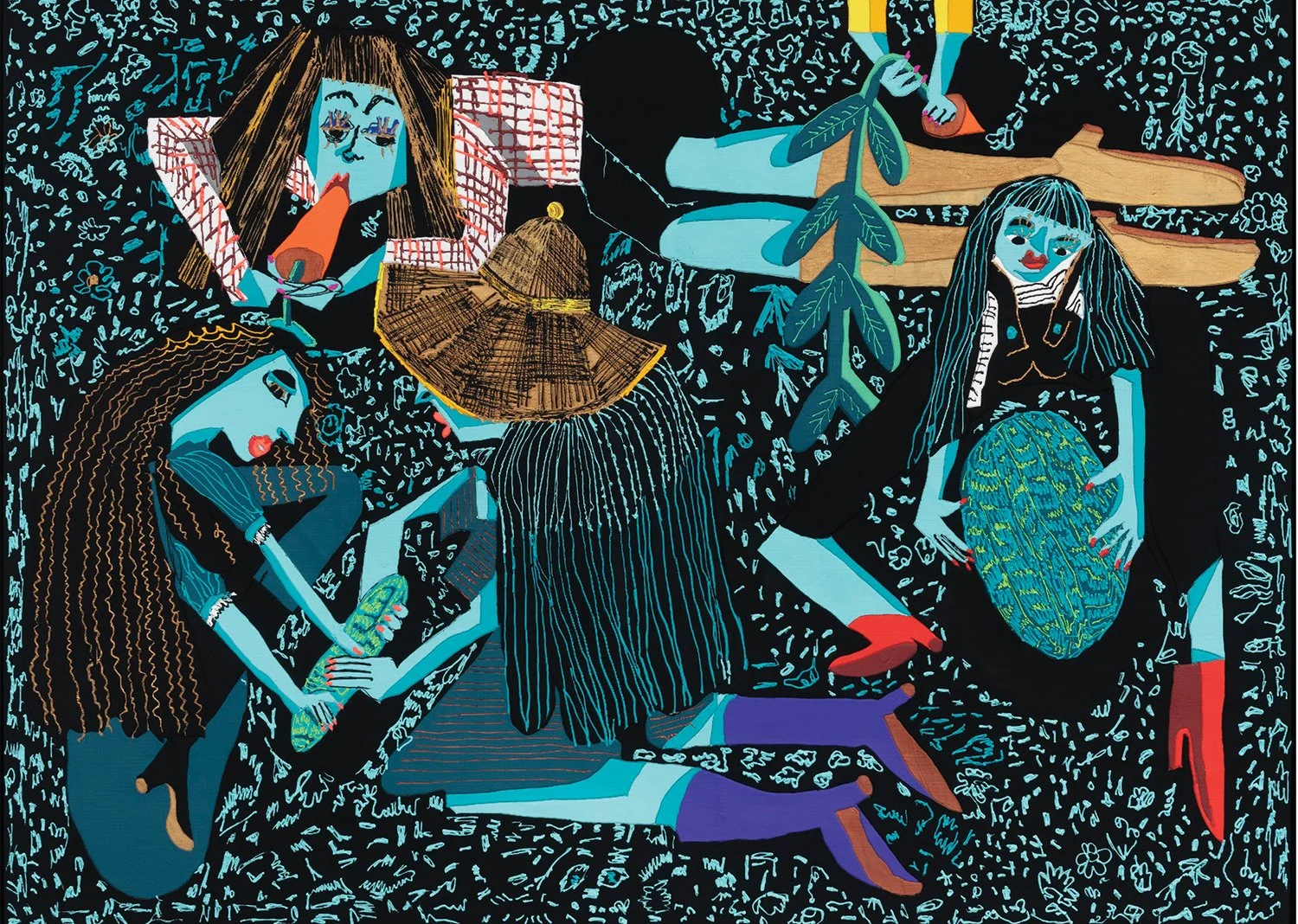Thirsty in the Sun, 2025. Acrylic paint and gouache on aluminum mesh, 69.75 x 48.75 x 2.25 inches. Courtesy of the artist and Nazarian / Curcio, Los Angeles
With a name like Summer Wheat, she is likely destined for lore. There’s something mythic in that combination — an earthbound season and a sustaining resource. When I moved to Savannah to work as a curator at the SCAD Museum of Art about four years ago, Summer Wheat’s name already carried legendary status on campus. I’d hear it whispered — she is someone to aspire to, an artist I should know. A student who had once walked these halls and an alumna who had reached the rarefied level of established artist.
Since graduating, Wheat has developed a recognizable, idiosyncratic style and a distinctive method of making. She is now represented by major galleries, exhibits internationally, and operates a staffed studio. The evolution of her practice can be traced across her pieces in the university’s collection, displayed throughout its buildings. Her earlier works burst with wild abandon: loose, gestural, expressionistic explosions (yes, it needs that many adjectives!), infused with angsty notes and poetic drawls, layered with satisfyingly thick globs and lacy lips of paint.
About a year ago, I had the chance to visit her studio in Ridgewood, Queens. She’s been there for over a decade, in a massive industrial building full of artist studios with white walls, gym floors, iron-paned windows, and an almost unobstructed view of Manhattan. Upon meeting Summer Wheat in person, I found that her name truly lived up to its lore. She radiates intensity — bright, warm, and sharp-witted. She is a wellspring of creativity, moving through the fields of her own making, in tune with the complex cycles of womanhood and artisthood. Her studio reflected this energy. It was filled to the brim with works-in-progress, laid out like a tinkerer’s wonderland.
I had heard of her utterly unique process for making paintings – how she uses pastry bags, extruders and squeegees to push an alchemical paint mixture through wire mesh, which, after drying, resembles a tapestry more than a painting. As a former pastry chef turned curator and art-cookie hobbyist, I was especially thrilled to see this process up close. Her studio was a feast for the eyes: expansive paintings, maquette models for dreamed-up projects, sparkling mosaic-tiled sculptures, prototypes for precious jewelry pieces. Wheat experiments with materials, transforming paint into something unexpected. The finished work retains both the impulses of intuition and the sharpness of editorial restraint. What struck me most, though, was the lingering sense of familiarity. Her artwork makes something distant — some memory or story from far away or long ago — feel tactile and present. Her work conjures a closeness that is physical and emotional. The textures are heightened. The forms are legible. It taps into something primal — the instinct to remember, to feel, to connect across time through material.
Flash forward to this year — I had the immense joy of working with Summer Wheat on her solo exhibition Fruits of Labor at the SCAD Museum of Art. To have a concentrated grouping of her works fresh from the studio, now on view at the museum, is such a treat. I am thrilled that students, the local community of Savannah and visitors from far and wide will experience these paintings up close for the first time. Wheat insisted on making a new suite of works for this exhibition, which takes place exactly twenty years after she earned her MFA in Painting from SCAD in 2005. There is something fortuitous about round numbers – maybe even cosmic. Could it be that some alignment brought us together for this moment? Legends are mysterious in the way they break through preconceptions or fulfill fantasies, how they evolve and shift in meaning over time. Read on to bask in the mystique, and hear from the living legend herself!
The artist in her studio, Photo by Ingrid Holmquist
Brittany Richmond: Summer, I’m so glad we get the chance to talk through this full-circle moment of yours and share your thoughts in print. It is such a meaningful milestone to have your work on view at SCAD MOA. The exhibition title Fruits of Labor feels especially fitting, not only in relation to the work in the show, but also in how it encapsulates the path that brought you here, back to Savannah, two decades after graduating from SCAD — and the gratitude and appreciation we have for your work! It was so special to witness you revisit this place, walk through the city, and reflect on how far you’ve come. You grew up in Oklahoma, studied at SCAD in Savannah for graduate school, and then moved to New York, where you have been based ever since. I wonder if you could share your journey so far from your perspective — through three formative experiences, or even three artworks that served as points of inspiration from those different chapters of your life — that really shaped you as an artist?
Summer Wheat: I think of my path less as a straight line and more like a braided river — multiple currents moving alongside each other, converging and diverging. Growing up in Oklahoma, one of my first formative experiences was being surrounded by the visual language of craft — quilts, beadwork, tooled leather — the ways women around me transformed humble materials into objects that carried stories.
The second chapter unfolded at SCAD, where I first began to feel the weight and possibility of art history pressing against my own experiments. I remember making a large figurative work that felt like I’d finally learned to “speak” in my own visual dialect — it was messy, ambitious, and unapologetic.
The third turning point came in New York, seeing Kara Walker’s silhouettes at the Whitney. That work cracked something open for me — the realization that beauty and brutality could co-exist on one surface, that historical narratives could be rewritten with sharp edges and lyrical forms. Those three touchpoints — craft traditions, self-discovery in grad school, and the courage to hold contradictions — still shape everything I do.
BR: Since this is a Savannah-based publication, I’d love to hear more about your time living and making art in Savannah. Looking back, after having lived in multiple places, is there anything about Savannah that really stayed with you — what do you find yourself missing most about it?
SW: Savannah left a deep imprint on me. I miss the light there – the way it comes through the Spanish moss and bounces off those old pastel houses. There's a kind of magic in how the city feels suspended in time, and that has shaped how I think about layering past and present in my work. I also miss the rhythm of the place – the pace is slower, and people take the time to tell stories. That sense of storytelling, history, and myth is something I carry with me everywhere.
Horse and Apples, 2025. Acrylic paint and gouache on aluminum mesh, 68 x 94 inches Courtesy of the artist and Nazarian/Curcio
BR: I remember you mentioning how, while working at the Savannah Trolley Company, you would draw on register tape — transforming them into scroll-like objects. In this current exhibition, with the shift in scale, your drawings now feel more like friezes or even cave paintings. These formats nod to the beginnings of human history and highlight how deeply drawing and mark-making are tied to communication and expression. I’m curious — are there narrative or literary elements in your work or that influence your work? Are the drawings episodic or sequential in some way? Is there anything specific you are hoping to communicate through them?
SW: My drawings are definitely narrative, though the stories aren't always linear. They're more like episodes or fragments that build on one another – motifs come back, characters shift, objects repeat but take on new meanings. It feels closer to oral history than to a novel: things are retold and reshaped each time. Right now, I'm reading books about quantum healing because I'm deeply interested in the healing arts, and I've also been watching a lot of old sci-fi films. I love the mix of myth, transformation, and everyday life in both — they feel timeless and futuristic at once, which is what I want my work to hold.
Bull with Oranges and Strawberries, 2025. Acrylic paint and gouache on aluminum mesh, 68 x 94 inches. Courtesy of the artist and Nazarian / Curcio
BR: There are six new paintings in the exhibition — we call them paintings, but they really exist across multiple mediums, defying categories! It always surprises visitors that the substrate is aluminum mesh, not canvas, and that it’s paint on the surface, not fibers. They’re incredibly layered, incorporating elements of drawing, painting, sculpture, printmaking, and even quilts/tapestries. How did this way of working develop for you, and why did you feel the need to invent it? Can you describe the life cycle of these paintings and reveal the intensity of the labor involved in making them?
Tiger with Banana, 2025. Acrylic paint and gouache on aluminum mesh, 68 x 94 inches. Courtesy of the artist and Nazarian / Curcio
SW: I think my materials found me as much as I found them. I started working with aluminum mesh because I wanted something that could hold both paint and light — a kind of net itself, both permeable and strong. The mesh lets me push paint through from the back, almost like a monoprint, then work the surface from the front. The result is this hybrid skin that holds drawing, sculpture, and painting in one plane.
Each work starts with sketches — both on paper and digitally — and then days of pushing pigment, scraping, re-layering. It’s an extremely physical process: I’m bending over, working from both sides, sometimes for weeks on a single section. The intensity comes from wanting the work to feel like it’s been lived in — as if you can still feel the echo of every touch that built it.
BR: The result of this process generates such rich visual and physical texture. Do you have any distinct memories of specific surfaces or textures out in the world that sparked your interest in exploring texture as a central part of your practice? Maybe even from early on, when you were a kid?
SW: As a kid I loved running my hands over walls, dirt, gravel – anything rough or bumpy. I'd notice the way peeling paint could create its own little landscape. Later, I became fascinated with mosaics and frescoes, especially those that were chipped and weathered but still radiating color and life. I think that sense of surfaces holding memory — whether it's a crumbling wall or a shiny stone – made me want to build texture into everything I do.
BR: Immediacy, tactility, and rawness really come through in the final work. Have you ever thought about whether performance or ritual plays a role in how you make and present your work?
SW: Absolutely. I think of making as a kind of durational performance, even if the audience is only me. The rhythm of pushing paint through the mesh, the repetition of marks, the bodily engagement — it has a ritual quality. The studio becomes a stage where I’m repeating gestures until they accumulate meaning. That might not be “performance art” in the traditional sense, but it’s deeply performative in its process.
Leap Frog, 2023. Acrylic paint and gouache on aluminum mesh, framed 69.75 x 48.75 inches. Courtesy of the artist and Nazarian / Curcio, Los Angeles
BR: Delineating space and creating structure seem to be deeply embedded in the logic of your compositions and the physical construction of your artworks. In Fruits of Labor, the works share a common background and color palette, with figures enmeshed in nets and grids. This careful attention to the power of space — its ability to transform, to prompt action, or to demand a response — also appears across your work, like the monumental four-story window installation Foragers and your upcoming Jewel House architectural project. Why is the idea of space important to you? What do these nets and grids represent for you?
SW: Space for me isn’t empty — it’s charged. Nets and grids are both protective and restrictive; they can hold you, but they can also trap you. In Fruits of Labor, the figures live inside this latticework of connections, which feels a lot like life — we’re bound to each other in ways that can nourish or constrain. My interest in space extends beyond paintings into architectural works like Foragers and Jewel House because I want viewers to feel inside the work, not just in front of it. A painting can be a room, and a room can be a painting.
BR: I've noticed that your work often does not include horizon lines, yet I still read them as landscapes of sorts. Sometimes, looking at your paintings, I feel like I’m encountering an archaeological site floating in a kind of virtual orbit. The build-up or collection of everyday objects and rudimentary tools reminds me of your Treasures series from 2015. It feels like you always treat each object with a kind of sacredness or reverence, enhancing the materiality and “thingness” of both the artwork and what you depict. How do you relate to the paintings that you make — are they more images, objects, or both? And what draws you to depict utilitarian, everyday things?
SW: I think of them as both. They're images, but they're also objects with a physical presence. I love painting tools and everyday things because they're records of human touch. A broom, a pot, a knife – these are humble objects, but they hold the history of labor and care. I want to honor them like relics, to elevate them as sacred, because they are part of how we build and sustain life.
BR: There's this organized chaos to your works, or maybe a gratifying mess, with repeated motifs in carefully considered constellations. Each composition is so busy, it seems to have a sonic component to it – it strikes me as visual noise! Does music influence your work? If this exhibition was a soundtrack – what would be some of the top songs on the playlist or what genre of music?
SW: Music is always in the studio with me. I think rhythm seeps into the way I repeat marks and build compositions. This exhibition would probably sound like a mix of Philip Glass and Beyoncé's Renaissance – layered, hypnotic, full of energy and celebration. There's also always a little punk thrown in – something raw and messy that keeps me moving.
Rivers, 2024. Acrylic paint and gouache on aluminum mesh, 69.75 x 95.75 x 2.25 inches. Courtesy of the artist and Nazarian / Curcio, Los Angeles
BR: In four large-scale paintings on view, you depict female figures lounging with animals — lions, bulls — creatures often associated with fear, yet here they appear calm, in harmony with the lush wildlife around them. Some figures are hoisting watermelons, while others are casting nets. This series marks a shift in your practice toward focusing on the aftermath, or the fruits of collective labor, rather than women engaged in labor itself as you have in your previous work. How do you think about depicting labor in your work — are you celebrating it, critiquing it, or both?
SW: Labor has always fascinated me, especially women’s labor, because so much of it is invisible. In earlier works, I wanted to make that work visible — women casting nets, hauling, sowing, building. With Fruits of Labor, I became interested in what happens after. The pause. The feast. The moment when the body is still strong from effort, but now it rests or celebrates. It’s not just about productivity; it’s about the cycles of work and reward. These scenes are imagined, but they’re rooted in real-world histories — agricultural, domestic, mythological — where women have always been both laborers and creators of abundance.
Groundwork, 2023. Acrylic paint and gouache on aluminum mesh, framed 69.5 x 95.5 inches
BR: In this exhibition, the color palette feels electric — jewel-toned and vibrant. In past shows, you’ve grouped works by warm or cool palettes, guiding viewers through shifts in temperature, energy, and vibration. Other times, your work has been limited to black, white, and gold, or leaned fully into intense color. There’s a real sensitivity to both physical and visual value in your choices. Can you talk about your approach to color — what draws you to certain palettes, and how value, color interaction, and pattern play into your practice?
SW: For me, color is about vibration. I think less in terms of rules and more in terms of energy – how colors push or pull against each other, how they hum when they're side by side. Sometimes I limit myself, almost like setting a constraint for a poem, and sometimes I want an explosion of color. The jewel tones in this show felt like adornment, like dressing up the work for a kind of ceremony.
BR: There’s incredible dynamism in how you render each figure or object between abstraction and representation. You’ve crafted a style that feels uniquely yours, yet also timeless and universal. How did you develop this distinctive approach to exaggerating or stylizing the body?
SW: I exaggerate and stylize the body because I’m not interested in perfect anatomy; I’m interested in emotional anatomy. I want the figures to carry both ancient weight — like they’ve walked out of a frieze — and the looseness of a sketch caught in motion. That tension between the archaic and the immediate keeps the work from settling into one time or place.
Foragers, 2020. The Mint Museum, Charlotte, NC
BR: The figures are not only stylized, but stylish! I love their outfits – fishnet dresses and stiletto boots is an amazing combination. What fashion inspires you?
SW: I'm drawn to clothing that's both protective and performative — armor and costume at once. Fishnets, sequins, boots — these all signal strength, but also joy and play. I look a lot at ancient dress – Egyptian jewelry, Etruscan patterns, quilt traditions. I want my figures to look like they're ready for battle and ready for dance.
BR: I want to talk about the lemon-frog! When you first showed me this painting, I gasped — it’s so iconic and original, it made me smile and laugh. But it also tugs at my heartstrings and feels anchored in some deep, ancestral memory. You mentioned these two animal-fruit hybrid paintings are meant to act like totems in the gallery space. Which Greek myths were you thinking about while making these paintings? What’s your astrological sign?
SW: Ah, the lemon-frog! Humor is part of survival, and I like when symbols can make you smile before you realize they’re also talismans. The animal-fruit hybrids are totems — they’re about transformation, abundance, and absurdity all at once. I was thinking about Greek myths of metamorphosis, where humans and gods shift into other forms, often to escape danger or to gain power. My astrological sign is Aquarius — an air sign with one foot in the present and the other in some imagined future — so I tend to see the world through an inventive, shape-shifting lens. All of these symbols filter into my paintings like coded language. I want them to feel like they could belong to some lost civilization, but also to your grandmother’s kitchen table.
BR: You’ve expanded your practice to making jewelry, mosaic seats, stained glass clad buildings, and I can’t wait to see what you do next! You once said in an interview that you would like to design a collection of marzipan. As the curator of this exhibition and as a baker of art cookies for @SugarCrits, I am so curious, why marzipan!?
Lemon Frog on Grid, 2025. Acrylic paint and gouache on aluminum mesh, 36 x 24 inches. Images courtesy of the artist and Nazarian / Curcio, Los Angeles
SW: I love marzipan because it's both food and sculpture. It's delicate but also decadent, saturated with color and flavor. My dream collection would be tiny, intricate objects — miniature tools, fruits, even little figurines painted with metallic lusters so they shimmer. They'd taste almond-rich and a little floral, like something too precious to eat but irresistible at the same time.
BR: You’ve accomplished so much in your career as an artist thus far. What projects are you most proud of and what are you looking forward to working on next? Do you have any goals for the future that we can manifest through this article?
SW: I'm proud of the projects that live in public space – stained-glass windows that change the light in a room, or mosaic seats that people sit on every day. Those works become part of daily life, and that feels meaningful. Going forward, I want to keep expanding at an architectural scale – creating immersive environments people can move through. And yes, maybe someday, a bakery-gallery for marzipan sculptures!
###

